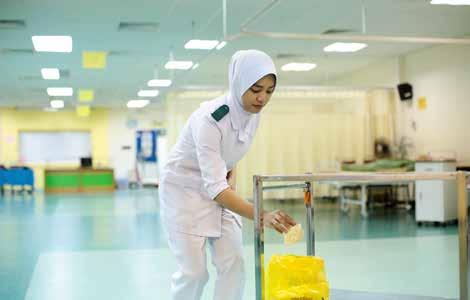
10 minute read
'De-cohorting' Post Pandemic: Are we There?
from Inside News December 2021
by RANZCR
Despite general acceptance (and relief) that the health systems in Australia and New Zealand have weathered the COVID crisis reasonably well over two hard years, hopes for a rapid return to normality in the third have dimmed markedly.
As medical experts grapple with the implications of waning vaccine efficacy in 2022 and the potential for new variants and novel viral threats in the longer term, the future looks uncertain, and calls for new and urgent investment in health care are growing. So, what can we reasonably expect the new year to hold, and what remains to be done?
Internationally, the COVID-19 pandemic—the fifth pandemic in a century—has to date killed in excess of five million people (second only in number of deaths to the Spanish flu pandemic of 1918–19) and devastated the lives of tens of millions more, economically, educationally and socially.1
The global impacts are likely to be felt for many years, especially among the poor and middle-income nations. The World Health Assembly, the decision-making body of the World Health Organization (WHO), is currently seeking to develop a treaty on pandemic preparedness and response and, in May 2022, it is expected to examine proposals to give the WHO greater powers and resources to deal with future pandemics.2
Overworked, under-resourced

A recent survey in NSW hospitals found that 38 per cent of junior doctors admitted to making medical errors due to working excessive hours, while 47 per cent felt their personal safety was at risk from fatigue.3
The impact on senior clinicians and specialists may have been similar. The head of the College's Workforce Unit, Brendan Grabau, says many of the clinicians he speaks to are currently at risk of burnout. ‘They're really tired, they're doing long days and some are doing additional College work because our normal processes have been disrupted. . . they have just been slammed,’ he told Inside News.
One thing is clear: ‘COVID-normal’ is the catchphrase of the new decade. Health authorities do not expect a snap-back to pre-pandemic life any time soon, but rather an adaptation to a more or less permanent shift in healthcare delivery, including changes in the work of radiologists and radiation oncologists.
Some challenges facing medical practice are the result of general disruption across the health sector—for example, deferred elective surgery—while others are more specific to radiological practice, such as later-than-normal presentation by cancer patients due to lockdowns and postponed check-ups.
The head of interventional radiology (IR) at The Alfred and incoming Dean of the Faculty of Clinical Radiology, Gerard Goh, says IR is again ‘very busy’ as deferred procedures have lengthened waiting lists and pushed many category 2 and 3 patients into category 1 and 2, respectively, requiring more urgent treatment. In addition, ‘the number of COVID and suspected COVID patients here has been significant, which increases pressure on our waitlist because these patients typically take much longer’ to process, he said.
Dr Grabau says a lack of relevant data is hampering efforts to interpret for medical administrators the impact of workload increases in clinical radiology which predate the pandemic but may have accelerated since its arrival.
The College is currently undertaking analysis to better measure the workload generated by not just the number of radiological studies performed, but also the complexity of each study and the detail within each image assessed.
Clin A/Prof Jeganathan does not expect a normalisation of care in clinical radiology and radiation oncology practice in 2022 and he has highlighted both supply and demand issues facing the College and the specialties.
Dr Grabau notes that, due to the moratorium on inbound overseas travel, the College now has a backlog of applications from international medical graduates waiting for face-to-face interview and assessment, which will be difficult to process quickly.
In addition, the general public is seeking greater access to doctors because they have become more concerned about their health care. Among nondoctor medical staff, including nurses, radiographers and medical physicists, as well as non-medical staff, the shortages are ‘dire,’ A/Prof Jeganathan says. ‘This will be a huge problem for at least a few years. The existing workforce is working longer hours, with no leave or holidays, which is causing burnout’.
A/Prof Jeganathan expects many of the public health responses to the pandemic to remain for years to come, if not permanently. ‘Mask wearing, proper cleaning between patients, more PPE— these are measures that will stay with us for a long time, and that will add time and costs to carrying out our services,’ he said.
Medical waste
While the wearing of face masks has attracted a deluge of public attention and commentary, the general public is mostly unaware of the impacts of an explosion in the use of personal protection equipment (PPE) in health settings. Not least among these is the environmental impact of a muchincreased volume of medical waste, especially PPE made from treated latex or polypropylene. As the pandemic continues, so rises the risk of environmental contamination of marine and terrestrial habitats by plastics with limited or no biodegradability.
Medical waste is created in ‘phenomenal’ quantities worldwide, presenting serious challenges to the healthcare system during a pandemic, says A/Prof Goh. A recent media report mentioned that the Sunshine Hospital in Melbourne had experienced a 40 per cent rise in its clinical waste since the beginning of the pandemic, while estimates at other hospitals have ranged from 25 to 130 per cent, depending on the number of COVID patients admitted.4
A/Prof Goh says ‘there needs to be more research into safe and effective ways of recycling potentially contaminated PPE,’ while noting that radiologists can be smarter with PPE ‘at the patient-facing level’ and minimise unnecessary waste without compromising patient and staff safety.
Disrupted supplies
With the acute phase of the pandemic beginning to recede (at least for those countries fortunate enough to achieve high levels of vaccination), so emerges a raft—or perhaps ‘container ship’ is the better term—of chronic after-effects as the world reacts in myriad ways to the impact of the pandemic.
Not least among the after-effects is a serious disruption to global supply chains, including supplies of vital medicines and medical equipment. Radiologists claim they are experiencing shortages or delayed deliveries of various consumables, steroid injections, catheters, wires, embolisation devices and certain types of vacuum-assisted biopsy needles, to name just a few.
Lead times for replacing scanning equipment have stretched beyond six months in some instances, possibly due to a COVID-induced worldwide shortage of computer components.
Telehealth and tele-training
A public health measure that has enjoyed a mostly positive reception (and possibly a bright future) is telehealth, although it is unclear as yet if the Australian government will permanently list telehealth as a Medicare item in specialist care. The College issued its radiation oncology telehealth principles in late August 2021, arguing that telehealth in radiological practice was a vital innovation for extending multidisciplinary care to rural and regional patients and lowering associated costs.
Meanwhile, Dr Grabau says the College has now largely shifted training and assessment online. ‘In our clinical exam, which is normally face-to-face, we used a digital version of that this year, with examiners in different states, putting images up on a screen and asking candidates to talk about the images.’
The College is also looking at other technology which would enable remote proctoring and improve exam security. ‘It's a huge shift in the way we do exams,’ he said. The College can now run its annual scientific meeting entirely online and will deliver CPD workshops in a similar fashion. However, despite achieving good progress in the transition to online assessment, applications from trainees for special consideration have risen in the wake of the changes, a reminder that all change comes at a cost.
Nevertheless, most agree that the move online for consultations, multidisciplinary meetings, training and assessment will continue. ‘This is a big game changer for us,’ says A/Prof Jeganathan.
Recovery
Finally, as we contemplate a COVID-normal world, health experts have sounded the call for a recovery phase at the end of the ‘final post-vaccination phase’ in which Australia moves away from major lockdowns and border closures.
Victoria's chief public health officer Brett Sutton and the health economist Stephen Duckett are among those critical of the national COVID roadmap for assuming the nation can ‘soon heave a sigh of relief and simply move on.’ Instead, we need time and money for recovery, by which the authors mean (i) ‘time out’ for health workers to recover from the increased workload and stress; and (ii) investment and reform to address the inequalities exposed in the health system by the pandemic.

‘The real lesson of the pandemic,’ they write, derives from the assumption that respiratory viruses spread randomly through the population—they do not. Instead, they spread differentially in line with the social drivers of health, including job security, income, homelessness, overcrowding, low literacy and cultural marginalisation. ‘In 2022, public health practitioners and organisations must seek to better understand these social drivers of health . . . and receive the resources to redress disparities exacerbated by the crisis’.5
It is a view reiterated in New Zealand by senior radiologists such as Helen Moore at Auckland Hospital. Dr Moore says the pandemic has compounded the problems created by years of neglect in infrastructure investment and chronic understaffing among medical officers.
These issues go well beyond the ambit of the radiologists but, given the pivotal role played by radiological medicine in diagnosis and treatment, and the considerable investments required in public and private practice to maintain their services, the time may have arrived for these specialists to step up and have their say about which resources are needed and where.
References
1 The World Bank, “World Bank/IMF Annual Meetings 2021: Development Committee Communiqué,” October 15, 2021, https://www.worldbank.org/en/news/pressrelease/2021/10/15/world-bank-imf-annual-meetings-2021-development-committee-communiqu
2 H.E. Ellen Johnson Sirleaf and Rt Hon. Helen Clark, “Losing time: End this pandemic and secure the future,” Independent Panel for Pandemic Preparedness and Response, WHO, November 21, 2021, https://theindependentpanel.org/mainreport/
3 Lucy Carroll, “Junior doctors report increased bullying in NSW hospitals, stress leading to mistakes,” The Sydney Morning Herald, November 17, 2021, https://www. theage.com.au/national/junior-doctors-report-increased-bullying-in-nsw-hospitals-stress-leading-to-mistakes-20211116-p599bx.html#comments
4 Emilia Terzon, “Australia's healthcare system is generating tonnes of COVID waste,” The Business, October 13, 2021, https://www.abc.net.au/news/2021-10-13/ healthcare-waste-COVID-plastic-recycling-reusing-hospitals/100533552
5 Stephen J. Duckett and Brett Sutton, “On entering Australia's third year with COVID-19,” MJA, October 27, 2021, http://doi.org/10.5694/mja2.51328










